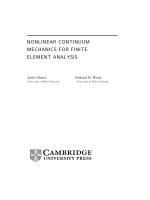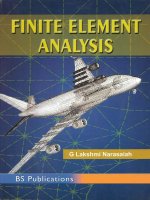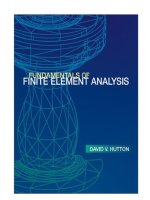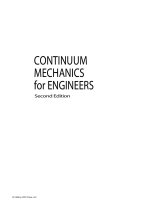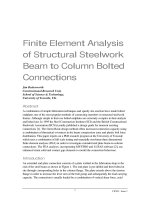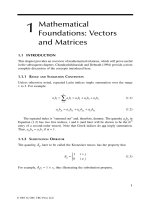- Trang chủ >>
- Khoa Học Tự Nhiên >>
- Vật lý
Nonlinear continuum mechanics for finite element analysis bonet, wood
Bạn đang xem bản rút gọn của tài liệu. Xem và tải ngay bản đầy đủ của tài liệu tại đây (1.97 MB, 279 trang )
NONLINEAR CONTINUUM
MECHANICS FOR FINITE
ELEMENT ANALYSIS
Javier Bonet
University of Wales Swansea
Richard D. Wood
University of Wales Swansea
PUBLISHED BY THE PRESS SYNDICATE OF THE UNIVERSITY OF CAMBRIDGE
The Pitt Building, Trumpington Street, Cambridge CB2 1RP, United Kingdom
CAMBRIDGE UNIVERSITY PRESS
The Edinburgh Building, Cambridge CB2 2RU, United Kingdom
40 West 20th Street, New York, NY 10011-4211, USA
10 Stamford Road, Oakleigh, Melbourne 3166, Australia
c Cambridge University Press 1997
This book is in copyright. Subject to statutory exception
and to the provisions of relevant collective licensing agreements,
no reproduction of any part may take place without
the written permission of Cambridge University Press.
First published 1997
Printed in the United States of America
Typeset in Times and Univers
Library of Congress Cataloging-in-Publication Data
Bonet, Javier, 1961–
Nonlinear continuum mechanics for finite element analysis / Javier
Bonet, Richard D. Wood.
p.
cm.
ISBN 0-521-57272-X
1. Materials – Mathematical models. 2. Continuum mechanics.
3. Nonlinear mechanics. 4. Finite element method. I. Wood.
Richard D. II. Title.
TA405.B645
1997
620.1 1 015118 – dc21
97-11366
CIP
A catalog record for this book is available from
the British Library.
ISBN 0 521 57272 X hardback
iv
To Catherine, Doreen and our children
v
vi
CONTENTS
xiii
Preface
1 INTRODUCTION
1.1 NONLINEAR COMPUTATIONAL MECHANICS
1
1
1.2 SIMPLE EXAMPLES OF NONLINEAR STRUCTURAL BEHAVIOR
2
1.2.1 Cantilever
2
1.2.2 Column
3
1.3 NONLINEAR STRAIN MEASURES
4
1.3.1 One-Dimensional Strain Measures
5
1.3.2 Nonlinear Truss Example
6
1.3.3 Continuum Strain Measures
1.4 DIRECTIONAL DERIVATIVE, LINEARIZATION AND
EQUATION SOLUTION
10
13
1.4.1 Directional Derivative
14
1.4.2 Linearization and Solution of Nonlinear
Algebraic Equations
16
2 MATHEMATICAL PRELIMINARIES
21
2.1 INTRODUCTION
21
2.2 VECTOR AND TENSOR ALGEBRA
21
2.2.1 Vectors
22
2.2.2 Second-Order Tensors
26
2.2.3 Vector and Tensor Invariants
33
vii
viii
2.2.4 Higher-Order Tensors
2.3 LINEARIZATION AND THE DIRECTIONAL DERIVATIVE
37
43
2.3.1 One Degree of Freedom
43
2.3.2 General Solution to a Nonlinear Problem
44
2.3.3 Properties of the Directional Derivative
47
2.3.4 Examples of Linearization
48
2.4 TENSOR ANALYSIS
52
2.4.1 The Gradient and Divergence Operators
52
2.4.2 Integration Theorems
54
3 KINEMATICS
57
3.1 INTRODUCTION
57
3.2 THE MOTION
57
3.3 MATERIAL AND SPATIAL DESCRIPTIONS
59
3.4 DEFORMATION GRADIENT
61
3.5 STRAIN
64
3.6 POLAR DECOMPOSITION
68
3.7 VOLUME CHANGE
73
3.8 DISTORTIONAL COMPONENT OF THE DEFORMATION
GRADIENT
74
3.9 AREA CHANGE
77
3.10 LINEARIZED KINEMATICS
78
3.10.1 Linearized Deformation Gradient
78
3.10.2 Linearized Strain
79
3.10.3 Linearized Volume Change
80
3.11 VELOCITY AND MATERIAL TIME DERIVATIVES
80
3.11.1 Velocity
80
3.11.2 Material Time Derivative
81
3.11.3 Directional Derivative and Time Rates
82
3.11.4 Velocity Gradient
83
3.12 RATE OF DEFORMATION
84
3.13 SPIN TENSOR
87
ix
3.14 RATE OF CHANGE OF VOLUME
3.15 SUPERIMPOSED RIGID BODY MOTIONS AND OBJECTIVITY
4 STRESS AND EQUILIBRIUM
90
92
96
4.1 INTRODUCTION
96
4.2 CAUCHY STRESS TENSOR
96
4.2.1 Definition
4.2.2 Stress Objectivity
4.3 EQUILIBRIUM
96
101
101
4.3.1 Translational Equilibrium
101
4.3.2 Rotational Equilibrium
103
4.4 PRINCIPLE OF VIRTUAL WORK
104
4.5 WORK CONJUGACY AND STRESS REPRESENTATIONS
106
4.5.1 The Kirchhoff Stress Tensor
106
4.5.2 The First Piola–Kirchhoff Stress Tensor
107
4.5.3 The Second Piola–Kirchhoff Stress Tensor
109
4.5.4 Deviatoric and Pressure Components
112
4.6 STRESS RATES
113
5 HYPERELASTICITY
117
5.1 INTRODUCTION
117
5.2 HYPERELASTICITY
117
5.3 ELASTICITY TENSOR
119
5.3.1 The Material or Lagrangian Elasticity Tensor
119
5.3.2 The Spatial or Eulerian Elasticity Tensor
120
5.4 ISOTROPIC HYPERELASTICITY
121
5.4.1 Material Description
121
5.4.2 Spatial Description
122
5.4.3 Compressible Neo-Hookean Material
124
5.5 INCOMPRESSIBLE AND NEARLY
INCOMPRESSIBLE MATERIALS
126
5.5.1 Incompressible Elasticity
126
5.5.2 Incompressible Neo-Hookean Material
129
5.5.3 Nearly Incompressible Hyperelastic Materials
131
x
5.6 ISOTROPIC ELASTICITY IN PRINCIPAL DIRECTIONS
134
5.6.1 Material Description
134
5.6.2 Spatial Description
135
5.6.3 Material Elasticity Tensor
136
5.6.4 Spatial Elasticity Tensor
137
5.6.5 A Simple Stretch-Based Hyperelastic Material
138
5.6.6 Nearly Incompressible Material in Principal Directions
139
5.6.7 Plane Strain and Plane Stress Cases
142
5.6.8 Uniaxial Rod Case
143
6 LINEARIZED EQUILIBRIUM EQUATIONS
146
6.1 INTRODUCTION
146
6.2 LINEARIZATION AND NEWTON–RAPHSON PROCESS
146
6.3 LAGRANGIAN LINEARIZED INTERNAL VIRTUAL WORK
148
6.4 EULERIAN LINEARIZED INTERNAL VIRTUAL WORK
149
6.5 LINEARIZED EXTERNAL VIRTUAL WORK
150
6.5.1 Body Forces
151
6.5.2 Surface Forces
151
6.6 VARIATIONAL METHODS AND INCOMPRESSIBILITY
153
6.6.1 Total Potential Energy and Equilibrium
154
6.6.2 Lagrange Multiplier Approach to Incompressibility
154
6.6.3 Penalty Methods for Incompressibility
157
6.6.4 Hu-Washizu Variational Principle for Incompressibility
158
6.6.5 Mean Dilatation Procedure
160
7 DISCRETIZATION AND SOLUTION
165
7.1 INTRODUCTION
165
7.2 DISCRETIZED KINEMATICS
165
7.3 DISCRETIZED EQUILIBRIUM EQUATIONS
170
7.3.1 General Derivation
170
7.3.2 Derivation in Matrix Notation
172
7.4 DISCRETIZATION OF THE LINEARIZED
EQUILIBRIUM EQUATIONS
173
7.4.1 Constitutive Component – Indicial Form
174
xi
7.4.2 Constitutive Component – Matrix Form
176
7.4.3 Initial Stress Component
177
7.4.4 External Force Component
178
7.4.5 Tangent Matrix
180
7.5 MEAN DILATATION METHOD FOR INCOMPRESSIBILITY
182
7.5.1 Implementation of the Mean Dilatation Method
182
7.6 NEWTON–RAPHSON ITERATION AND SOLUTION
PROCEDURE
184
7.6.1 Newton–Raphson Solution Algorithm
184
7.6.2 Line Search Method
185
7.6.3 Arc Length Method
187
8 COMPUTER IMPLEMENTATION
191
8.1 INTRODUCTION
191
8.2 USER INSTRUCTIONS
192
8.3 OUTPUT FILE DESCRIPTION
196
8.4 ELEMENT TYPES
197
8.5 SOLVER DETAILS
200
8.6 CONSTITUTIVE EQUATION SUMMARY
201
8.7 PROGRAM STRUCTURE
206
8.8 MAIN ROUTINE flagshyp
206
8.9 ROUTINE elemtk
214
8.10 ROUTINE ksigma
220
8.11 ROUTINE bpress
221
8.12 EXAMPLES
223
8.12.1 Simple Patch Test
223
8.12.2 Nonlinear Truss
224
8.12.3 Strip With a Hole
225
8.12.4 Plane Strain Nearly Incompressible Strip
225
8.13 APPENDIX : Dictionary of Main Variables
APPENDIX LARGE INELASTIC DEFORMATIONS
227
231
A.1 INTRODUCTION
231
A.2 THE MULTIPLICATIVE DECOMPOSITION
232
xii
A.3 PRINCIPAL DIRECTIONS
234
A.4 INCREMENTAL KINEMATICS
236
A.5 VON MISES PLASTICITY
238
A.5.1 Stress Evaluation
238
A.5.2 The Radial Return Mapping
239
A.5.3 Tangent Modulus
240
Bibliography
243
Index
245
PREFACE
A fundamental aspect of engineering is the desire to design artifacts that
exploit materials to a maximum in terms of performance under working conditions and efficiency of manufacture. Such an activity demands an increasing understanding of the behavior of the artifact in its working environment
together with an understanding of the mechanical processes occuring during
manufacture.
To be able to achieve these goals it is likely that the engineer will need
to consider the nonlinear characteristics associated possibly with the manufacturing process but certainly with the response to working load. Currently
analysis is most likely to involve a computer simulation of the behavior. Because of the availability of commercial finite element computer software, the
opportunity for such nonlinear analysis is becoming increasingly realized.
Such a situation has an immediate educational implication because, for
computer programs to be used sensibly and for the results to be interpreted
wisely, it is essential that the users have some familiarity with the fundamentals of nonlinear continuum mechanics, nonlinear finite element formulations, and the solution techniques employed by the software. This book
seeks to address this problem by providing a unified introduction to these
three topics.
The style and content of the book obviously reflect the attributes and
abilities of the authors. Both authors have lectured on this material for a
number of years to postgraduate classes, and the book has emerged from
these courses. We hope that our complementary approaches to the topic
will be in tune with the variety of backgrounds expected of our readers
and, ultimately, that the book will provide a measure of enjoyment brought
about by a greater understanding of what we regard as a fascinating subject.
xiii
xiv
PREFACE
Although the content has been jointly written, the first author was the
primary contributor to Chapter 5, on hyperelasticity, and the Appendix, on
inelastic deformation. In addition, he had the stamina to write the computer
program.
READERSHIP
This book is most suited to a postgraduate level of study by those either
in higher education or in industry who have graduated with an engineering
or applied mathematics degree. However the material is equally applicable to first-degree students in the final year of an applied maths course or
an engineering course containing some additional emphasis on maths and
numerical analysis. A familiarity with statics and elementary stress analysis is assumed, as is some exposure to the principles of the finite element
method. However, a primary objective of the book is that it be reasonably self-contained, particularly with respect to the nonlinear continuum
mechanics chapters, which comprise a large portion of the content.
When dealing with such a complex set of topics it is unreasonable to
expect all readers to become familiar with all aspects of the text. If the
reader is prepared not to get too hung up on details, it is possible to use the
book to obtain a reasonable overview of the subject. Such an approach may
be suitable for someone starting to use a nonlinear computer program. Alternatively, the requirements of a research project may necessitate a deeper
understanding of the concepts discussed. To assist in this latter endeavour
the book includes a computer program for the nonlinear finite deformation
finite element analysis of two- and three-dimensional solids. Such a program provides the basis for a contemporary approach to finite deformation
elastoplastic analysis.
LAYOUT
Chapter 1 – Introduction
Here the nature of nonlinear computational mechanics is discussed followed
by a series of very simple examples that demonstrate various aspects of
nonlinear structural behavior. These examples are intended, to an extent,
to upset the reader’s preconceived ideas inherited from an overexposure to
linear analysis and, we hope, provide a motivation for reading the rest of
PREFACE
xv
the book! Nonlinear strain measures are introduced and illustrated using
a simple one-degree-of-freedom truss analysis. The concepts of linearization and the directional derivative are of sufficient importance to merit a
gentle introduction in this chapter. Linearization naturally leads on to the
Newton–Raphson iterative solution, which is the fundamental way of solving the nonlinear equilibrium equations occurring in finite element analysis.
Consequently, by way of an example, the simple truss is solved and a short
FORTRAN program is presented that, in essence, is the prototype for the
main finite element program discussed later in the book.
Chapter 2 – Mathematical Preliminaries
Vector and tensor manipulations occur throughout the text, and these are
introduced in this chapter. Although vector algebra is a well-known topic,
tensor algebra is less familiar, certainly, to many approaching the subject
with an engineering educational background. Consequently, tensor algebra
is considered in enough detail to cover the needs of the subsequent chapters,
and in particular, it is hoped that readers will understand the physical interpretation of a second-order tensor. Crucial to the development of the finite
element solution scheme is the concept of linearization and the directional
derivative. The introduction provided in Chapter 1 is now thoroughly developed. Finally, for completeness, some standard analysis topics are briefly
presented.
Chapter 3 – Kinematics
This chapter deals with the kinematics of finite deformation, that is, the
study of motion without reference to the cause. Central to this concept is
the deformation gradient tensor, which describes the relationship between
elemental vectors defining neighboring particles in the undeformed and deformed configurations of the body whose motion is under consideration.
The deformation gradient permeates most of the development of finite deformation kinematics because, among other things, it enables a variety of
definitions of strain to be established. Material (initial) and spatial (current) descriptions of various items are discussed, as is the linearization of
kinematic quantities. Although dynamics is not the subject of this text, it
is nevertheless necessary to consider velocity and the rate of deformation.
The chapter concludes with a brief discussion of rigid body motion and
objectivity.
xvi
PREFACE
Chapter 4 – Stress and Equilibrium
The definition of the true or Cauchy stress is followed by the development
of standard differential equilibrium equations. As a prelude to the finite
element development the equilibrium equations are recast in the weak integral virtual work form. Although initially in the spatial or current deformed
configuration, these equations are reformulated in terms of the material or
undeformed configuration, and as a consequence alternative stress measures
emerge. Finally, stress rates are discussed in preparation for the following
chapter on hyperelasticity.
Chapter 5 – Hyperelasticity
Hyperelasticity, whereby the stress is found as a derivative of some potential
energy function, encompasses many types of nonlinear material behavior and
provides the basis for the finite element treatment of elastoplastic behavior
(see Appendix A). Isotropic hyperelasticity is considered both in a material
and in a spatial description for compressible and incompressible behavior.
The topic is extended to a general description in principle directions that is
specialized for the cases of plane strain, plane stress and uniaxial behavior.
Chapter 6 – Linearized Equilibrium Equations
To establish the Newton–Raphson solution procedure the virtual work expression of equilibrium may be linearized either before or after discretization. Here the former approach is adopted. Linearization of the equilibrium
equations includes consideration of deformation-dependant surface pressure
loading. A large proportion of this chapter is devoted to incompressibility
and to the development, via the Hu-Washizu principle, of the mean dilatation technique.
Chapter 7 – Discretization and Solution
All previous chapters have provided the foundation for the development of
the discretized equilibrium and linearized equilibrium equations considered
in this chapter. Linearization of the virtual work equation leads to the familiar finite element expression of equilibrium involving B T σdv, whereas
discretization of the linearized equilibrium equations leads to the tangent
matrix, which comprises constitutive and initial stress components. Discretization of the mean dilatation technique is presented in detail. The
tangent matrix forms the basis of the Newton–Raphson solution procedure,
PREFACE
xvii
which is presented as the fundamental solution technique enshrined in the
computer program discussed in the following chapter. The chapter concludes with a discussion of line search and arc length enhancement to the
Newton–Raphson procedure.
Chapter 8 – Computer Implementation
Here information is presented on a nonlinear finite element computer program for the solution of finite deformation finite element problems employing
the neo-Hookean hyperelastic compressible and incompressible constitutive
equations developed in Chapter 5. The usage and layout of the FORTRAN
program is discussed together with the function of the various key subroutines. The actual program is available free on the Internet.
The source program can be accessed via the ftp site: ftp.swansea.ac.uk
use “anonymous” user name and go to directory pub/civeng
and get flagshyp.f.
Alternatively access the WWW site address:
http://www. swansea.ac.uk/civeng/Research/Software/flagshyp/ to
obtain the program and updates.
Appendix – Introduction to Large Inelastic Deformations
This appendix is provided for those who wish to gain an insight into the
topic of finite deformation elastoplastic behavior. Because the topic is extensive and still the subject of current research, only a short introduction
is provided. The Appendix briefly extends the basic nonlinear kinematics
of Chapter 3 to cater for the elastoplastic multiplicative decomposition of
the deformation gradient required for the treatment of elastoplastic finite
deformation. In particular, Von-Mises behavior is considered together with
the associated radial return and tangent modulus expressions.
Finally, a bibliography is provided that enables the reader to access the
background to the more standard aspects of finite element analysis, also
listed are texts and papers that have been of use in the preparation of this
book and that cover material in greater depth.
xviii
CHAPTER ONE
INTRODUCTION
1.1 NONLINEAR COMPUTATIONAL MECHANICS
Two sources of nonlinearity exist in the analysis of solid continua, namely,
material and geometric nonlinearity. The former occurs when, for whatever
reason, the stress strain behavior given by the constitutive relation is nonlinear, whereas the latter is important when changes in geometry, however large
or small, have a significant effect on the load deformation behavior. Material
nonlinearity can be considered to encompass contact friction, whereas geometric nonlinearity includes deformation-dependent boundary conditions
and loading.
Despite the obvious success of the assumption of linearity in engineering
analysis it is equally obvious that many situations demand consideration
of nonlinear behavior. For example, ultimate load analysis of structures
involves material nonlinearity and perhaps geometric nonlinearity, and any
metal-forming analysis such as forging or crash-worthiness must include both
aspects of nonlinearity. Structural instability is inherently a geometric nonlinear phenomenon, as is the behavior of tension structures. Indeed the
mechanical behavior of the human body itself, say in impact analysis, involves both types of nonlinearity. Nonlinear and linear continuum mechanics
deal with the same subjects such as kinematics, stress and equilibrium, and
constitutive behavior. But in the linear case an assumption is made that
the deformation is sufficiently small to enable the effect of changes in the
geometrical configuration of the solid to be ignored, whereas in the nonlinear
case the magnitude of the deformation is unrestricted.
Practical stress analysis of solids and structures is unlikely to be served
by classical methods, and currently numerical analysis, predominately in the
1
2
INTRODUCTION
form of the finite element method, is the only route by which the behavior of a complex component subject to complex loading can be successfully
simulated. The study of the numerical analysis of nonlinear continua using
a computer is called nonlinear computational mechanics, which, when applied specifically to the investigation of solid continua, comprises nonlinear
continuum mechanics together with the numerical schemes for solving the
resulting governing equations.
The finite element method may be summarized as follows. It is a procedure whereby the continuum behavior described at an infinity of points
is approximated in terms of a finite number of points, called nodes, located
at specific points in the continuum. These nodes are used to define regions,
called finite elements, over which both the geometry and the primary variables in the governing equations are approximated. For example, in the
stress analysis of a solid the finite element could be a tetrahedra defined by
four nodes and the primary variables the three displacements in the Cartesian directions. The governing equations describing the nonlinear behavior
of the solid are usually recast in a so-called weak integral form using, for
example, the principle of virtual work or the principle of stationary total
potential energy. The finite element approximations are then introduced
into these integral equations, and a standard textbook manipulation yields
a finite set of nonlinear algebraic equations in the primary variable. These
equations are then usually solved using the Newton–Raphson iterative technique.
The topic of this book can succinctly be stated as the exposition of the
nonlinear continuum mechanics necessary to develop the governing equations
in continuous and discrete form and the formulation of the Jacobian or
tangent matrix used in the Newton–Raphson solution of the resulting finite
set of nonlinear algebraic equations.
1.2 SIMPLE EXAMPLES OF NONLINEAR STRUCTURAL
BEHAVIOR
It is often the case that nonlinear behavior concurs with one’s intuitive
expectation of the behavior and that it is linear analysis that can yield the
nonsensical result. The following simple examples illustrate this point and
provide a gentle introduction to some aspects of nonlinear behavior. These
two examples consider rigid materials, but the structures undergo finite
displacements; consequently, they are classified as geometrically nonlinear
problems.
1.2
SIMPLE EXAMPLES OF NONLINEAR STRUCTURAL BEHAVIOR
3
L
FL/K
20
K
π/2
F
15
M=K
nonlinear
10
linear
F
5
F
0
Free body diagram
0 0.2 0.4 0.6 0.8 1 1.2 1.4 1.6
(a)
(b)
FIGURE 1.1 Simple cantilever.
1.2.1 CANTILEVER
Consider the weightless rigid bar-linear elastic torsion spring model of a
cantilever shown in Figure 1.1(a). Taking moments about the hinge gives
the equilibrium equation as,
FL cos θ = M
(1.1)
If K is the torsional stiffness of the spring, then M = Kθ and we obtain the
following nonlinear relationship between F and θ,
FL
θ
=
K
cos θ
(1.2)
If the angle θ → 0, then cos θ → 1, and the linear equilibrium equation
is recovered as,
F =
K
θ
L
(1.3)
The exact nonlinear equilibrium path is shown in Figure 1.1(b), where clearly
the nonlinear solution makes physical sense because θ < π/2.
1.2.2 COLUMN
The same bar-spring system is now positioned vertically (see Figure 1.2(a)),
and again moment equilibrium about the hinge gives,
PL sin θ = M
or
θ
PL
=
K
sin θ
(1.4)
4
INTRODUCTION
P
P
L
K
M=K
P
Free body diagram
PL/K
5
4.5
4
3.5
3
2.5
2
1.5
1
0.5
0
nonlinear
linear
−3 −2 −1
(a)
bifurcation
0
1
2
3
(b)
FIGURE 1.2 Simple column.
The above equilibrium equation can have two solutions: firstly if θ = 0, then
sin θ = 0, M = 0, and equilibrium is satisfied; and secondly, if θ = 0, then
PL/K = θ/ sin θ. These two solutions are shown in Figure 1.2(b), where
the vertical axis is the equilibrium path for θ = 0 and the horseshoe-shaped
equilibrium path is the second solution. The intersection of the two solutions
is called a bifurcation point. Observe that for PL/K < 1 there is only one
solution, namely θ = 0 but for PL/K > 1 there are three solutions. For
instance, when PL/K ≈ 1.57, either θ = 0 or ±π/2.
For very small values of θ, sin θ → θ and (1.4) reduces to the linear (in
θ) equation,
(K − PL)θ = 0
(1.5)
Again there are two solutions: θ = 0 or PL/K = 1 for any value of θ, the
latter solution being the horizontal path shown in Figure 1.2(b). Equation
(1.5) is a typical linear stability analysis where P = K/L is the elastic
critical (buckling) load. Applied to a beam column such a geometrically
nonlinear analysis would yield the Euler buckling load. In a finite element
context for, say, plates and shells this would result in an eigenvalue analysis,
the eigenvalues being the buckling loads and the eigenvectors being the
corresponding buckling modes.
Observe in these two cases that it is only by considering the finite displacement of the structures that a complete nonlinear solution has been
achieved.
1.3
5
NONLINEAR STRAIN MEASURES
L
A
a
l
FIGURE 1.3 One-dimensional strain.
1.3 NONLINEAR STRAIN MEASURES
In the examples presented in the previous section, the beam or column remained rigid during the deformation. In general structural components or
continuum bodies will exhibit large strains when undergoing a geometrically
nonlinear deformation process. As an introduction to the different ways in
which these large strains can be measured we consider first a one-dimensional
truss element and a simple example involving this type of structural component undergoing large displacements and large strains. We will then give
a brief introduction to the difficulties involved in the definition of correct
large strain measures in continuum situations.
1.3.1 ONE-DIMENSIONAL STRAIN MEASURES
Imagine that we have a truss member of initial length L and area A that is
stretched to a final length l and area a as shown in Figure 1.3. The simplest
possible quantity that we can use to measure the strain in the bar is the
so-called engineering strain εE defined as,
εE =
l−L
L
(1.6)
Clearly different measures of strain could be used. For instance, the change
in length ∆l = l − L could be divided by the final length rather than the
initial length. Whichever definition is used, if l ≈ L the small strain quantity
ε = ∆l/l is recovered.
An alternative large strain measure can be obtained by adding up all
the small strain increments that take place when the rod is continuously
stretched from its original length L to its final length l. This integration
6
INTRODUCTION
process leads to the definition of the natural or logarithmic strain εL as,
l
εL =
L
dl
l
= ln
l
L
(1.7)
Although the above strain definitions can in fact be extrapolated to
the deformation of a three-dimensional continuum body, this generalization
process is complex and computationally costly. Strain measures that are
much more readily generalized to continuum cases are the so-called Green
strain εG and Almansi strain εA defined as,
εG =
l2 − L2
2L2
(1.8a)
εA =
l2 − L2
2l2
(1.8b)
Irrespective of which strain definition is used, a simple Taylor series analysis shows that for the case where l ≈ L, all the above quantities converge
to the small strain definition ∆l/l. For instance, in the Green strain case,
we have,
εG (l ≈ L) ≈
(l + ∆l)2 − l2
2l2
1 l2 + ∆l2 + 2l∆l − l2
2
l2
∆l
≈
l
=
(1.9)
1.3.2 NONLINEAR TRUSS EXAMPLE
This example is included in order to introduce a number of features associated with finite deformation analysis. Later, in Section 1.4, a small
FORTRAN program will be given to solve the nonlinear equilibrium equation that results from the truss analysis. The structure of this program is,
in effect, a prototype of the general finite element program presented later
in this book.
We consider the truss member shown in Figure 1.4 with initial and
loaded lengths, cross-sectional areas and volumes: L, A, V and l, a, v respectively. For simplicity we assume that the material is incompressible and
hence V = v or AL = al. Two constitutive equations are chosen based,
without explanation at the moment, on Green’s and a logarithmic definition
1.3
7
NONLINEAR STRAIN MEASURES
F
B
l,a
,v
L,A
,V
x
A
X
D
FIGURE 1.4 Single incompressible truss member.
of strain, hence the Cauchy, or true, stress σ is either,
σ=E
l2 − L2
2L2
or σ = E ln
l
L
(1.10a,b)
where E is a constitutive constant that, in ignorance, has been chosen to
be the same irrespective of the strain measure being used. Physically this is
obviously wrong, but it will be shown below that for small strains it is acceptable. Indeed, it will be seen in Chapter 4 that the Cauchy stress cannot
be simply associated with Green’s strain, but for now such complications
will be ignored.
The equation for vertical equilibrium at the sliding joint B, in nomenclature that will be used later, is simply,
R(x) = T (x) − F = 0;
T = σa sin θ;
sin θ =
x
l
(1.11a,b,c)
where T (x) is the vertical component, at B, of the internal force in the
truss member and x gives the truss position. R(x) is the residual or out-ofbalance force, and a solution for x is achieved when R(x) = 0. In terms of
the alternative strain measures, T is,
T =
Evx l2 − L2
l2
2L2
or T =
Evx
l
ln
2
l
L
(1.12a,b)
Note that in this equation l is function of x as l2 = D2 + x2 and therefore
T is highly nonlinear in x.
Given a value of the external load F , the procedure that will eventually
be used to solve for the unknown position x is the Newton–Raphson method,
8
INTRODUCTION
Logarithmic
F/EA
0.4
Green
0.3
q
0.2
0.1
0
−0.1
− X/L
X/L
p0
−0.2
p
−0.3
−0.4
−4 −3 −2 −1 0
x/L
1
2
3
4
FIGURE 1.5 Truss example: load deflection behavior.
but in this one-degree-of-freedom case it is easier to choose a value for x and
find the corresponding load F . Typical results are shown in Figure 1.5, where
an initial angle of 45 degrees has been assumed. It is clear from this figure
that the behavior is highly nonlinear. Evidently, where finite deformations
are involved it appears as though care has to be exercised in defining the
constitutive relations because different strain choices will lead to different
solutions. But, at least, in the region where x is in the neighborhood of its
initial value X and strains are likely to be small, the equilibrium paths are
close.
In Figure 1.5 the local maximum and minimum forces F occur at the socalled limit points p and q, although in reality if the truss were compressed
to point p it would experience a violent movement or snap-through behavior
from p to point p as an attempt is made to increase the compressive load
in the truss beyond the limit point.
By making the truss member initially vertical we can examine the large
strain behavior of a rod. The typical load deflection behavior is shown in
Figure 1.6, where clearly the same constant E should not have been used to
represent the same material characterized using different strain measures.
Alternatively, by making the truss member initially horizontal, the stiffening
effect due to the development of tension in the member can be observed in
Figure 1.7.
Further insight into the nature of nonlinearity in the presence of large
deformation can be revealed by this simple example if we consider the vertical stiffness of the truss member at joint B. This stiffness is the change
in the equilibrium equation, R(x) = 0, due to a change in position x and is
1.3
9
NONLINEAR STRAIN MEASURES
F/EA
0.5
0.45
0.4
0.35
0.3
0.25
0.2
0.15
0.1
0.05
0
Green
Logarithmic
x/L
1
1.5
2
2.5
3
3.5
4
FIGURE 1.6 Large strain rod: load deflection behavior.
F/EA
0.3
0.25
Green
0.2
Logarithmic
0.15
0.1
0.05
x/L
0
0
1
2
FIGURE 1.7 Horizontal truss: tension stiffening.
generally represented by K = dR/dx. If the load F is constant, the stiffness
is the change in the vertical component, T , of the internal force, which can
be obtained with the help of Equations (1.11b,c) together with the incompressibility condition a = V /l as,
K=
=
dT
dx
d σV x
dx
l2
=
=a
ax dσ 2σax dl
σa
− 2
+
l dl
l
dx
l
dσ 2σ x2 σa
+
−
dl
l l2
l
(1.13)

